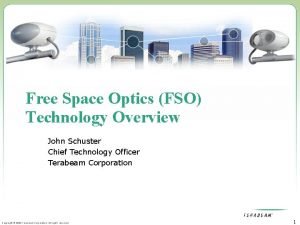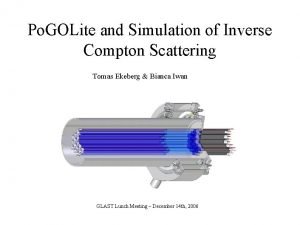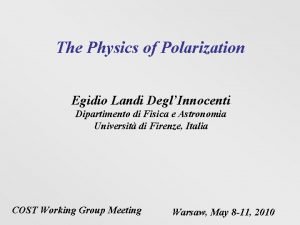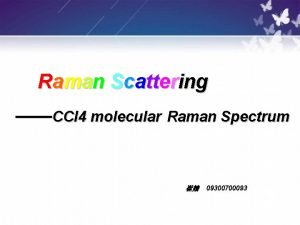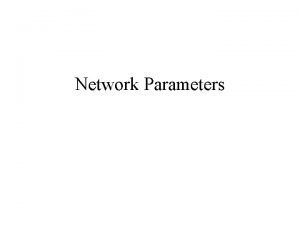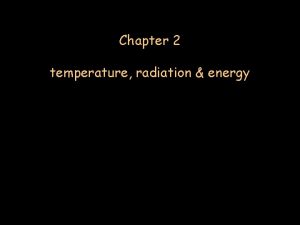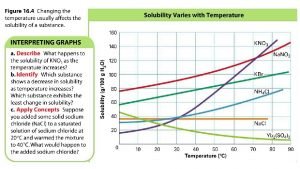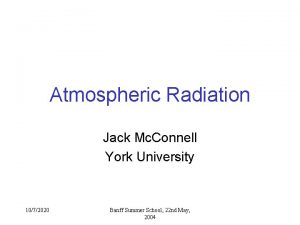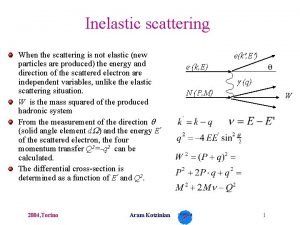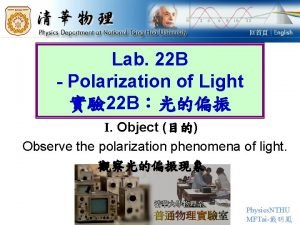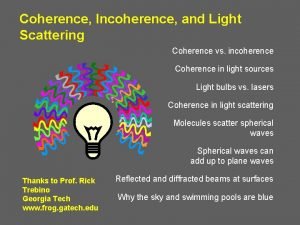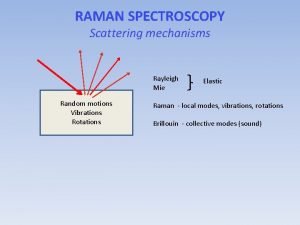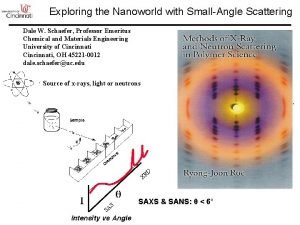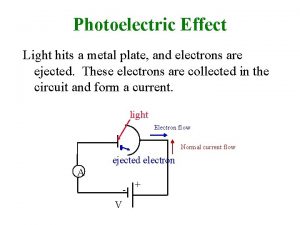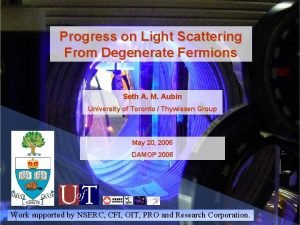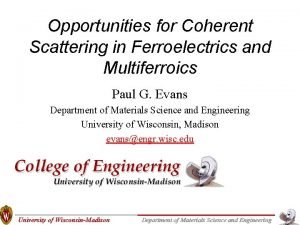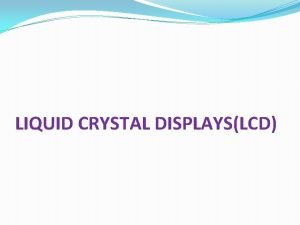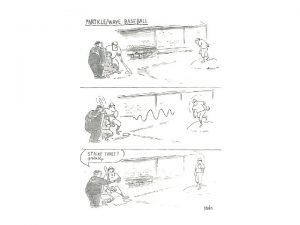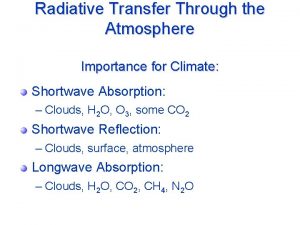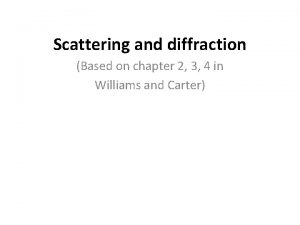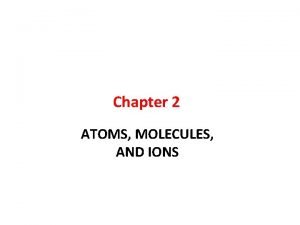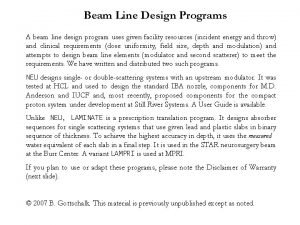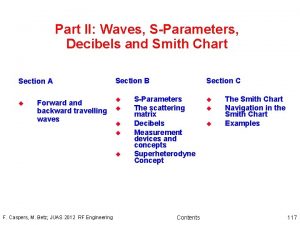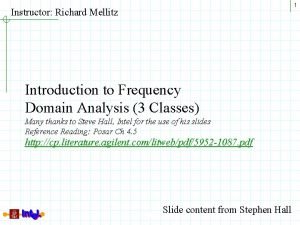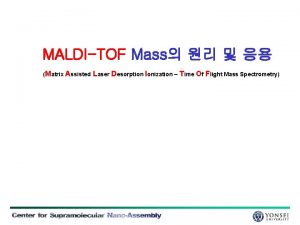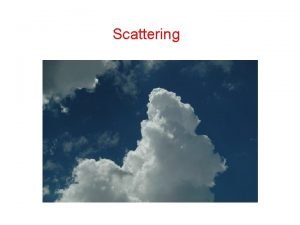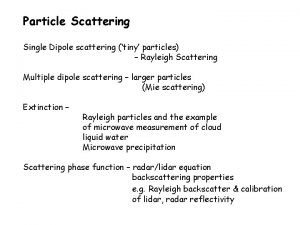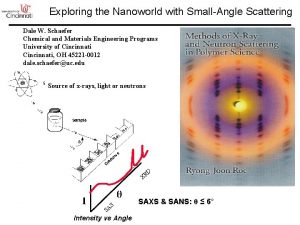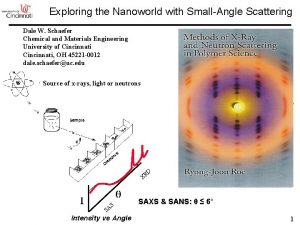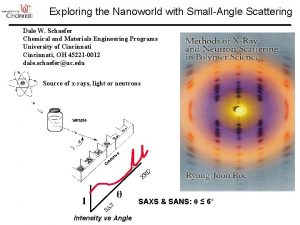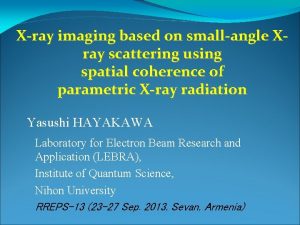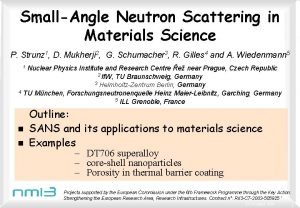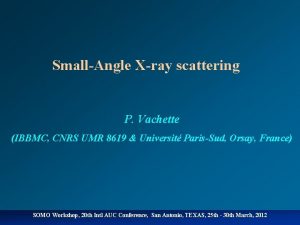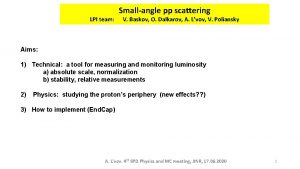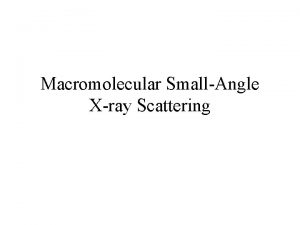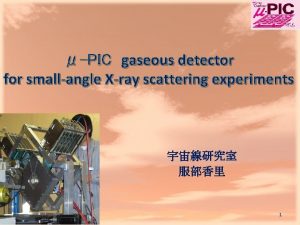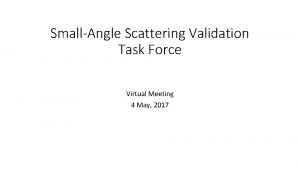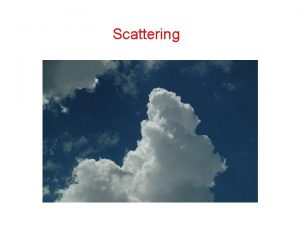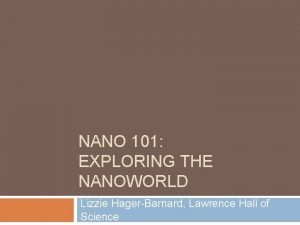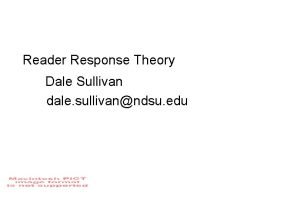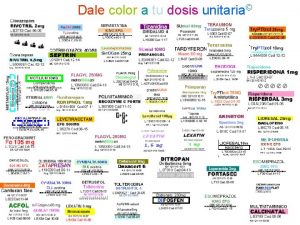Exploring the Nanoworld with SmallAngle Scattering Dale W
































- Slides: 32

Exploring the Nanoworld with Small-Angle Scattering Dale W. Schaefer Chemical and Materials Engineering Programs University of Cincinnati, OH 45221 -0012 dale. schaefer@uc. edu Source of x-rays, light or neutrons 1. Braggs Law and wave interference 2. Why do Small-Angle Scattering? 3. Imaging vs. Scattering 4. Basic Concepts 5. a) Scattering Vector, Fourier Trns. b) Scattering Length Density Particle Scattering a) Guinier Approximation b) Porod’s Law 6. Fractal Structures 7. Nanocomposites D XR AS S 9/6/2021 NX School 1 SAXS & SANS: θ ≤ 6°

Crystals: Bragg’s Law and the scattering vector, q source detector θ SAXS: θ < 6° d Reciprocal space 9/6/2021 NX School 2 1. 2. 3. 4. 5. Ordered Structures give peaks in “reciprocal” Space. Large structures scatter at small angles. The relevant size scale is determined by 2π/q q is a vector. You can’t always determine the real space structure from the scattering data. Problem: Nanomaterials are seldom ordered real space

Disordered Structures in “Real Space” Agglomerates 10µm Precipitated Silica (Na. O) (Si. O 2)3. 3 + HCl —> Si. O 2 + Na. Cl Water Glass Complex Hierarchical Disordered Aggregates 10 nm Difficult to quantify structure from images. Primary Particles 9/6/2021 NX School 3

Hierarchical Structure from Scattering Agglomerate Aggregate Primary Particle Network “Polymer” Four Length Scales Four Morphology Classes Real Space 100, 000 nm 200 nm 10 nm 0. 5 nm Intensity RG = 89 μ -3. 1 SAS -2. 0 Exponents related to morphology -4. 0 -7 10 9/6/2021 NX School 4 Reciprocal Space USAS -6 10 -5 10 0. 0001 0. 1 q [Å-1] ~ Length-1 ~ sin(θ/2) 1 10

Why Reciprocal Space? Isotactic polystyrene foams prepared by TIPS 10 µm 9/6/2021 NX School 5 Jim Aubert, SNL Images miss similarity Ultra-small-angle neutron scattering: a new tool for materials research. Cur. Opinion Sol. State & Mat Sci, 2004. 8(1): p. 39 -47.

Adding up the Phases Many electrons r 4 r 2 r 1 scattering length of one electron r 3 ρ(r) = bn(r) Amplitude is the Fourier transform of the SLD distribution (almost) Electron density distribution n(r) = number of electrons in a volume element dr = dx dy dz around point r. 9/6/2021 NX School 6 Scattering length density distribution ρ(r) = scattering length in a volume element dr = dx dy dz around point r.

Scattering Length Density (SLD) Distribution Fourier transform of the scattering length density distribution Can’t be measured ρ(r) Can’t be inverted What we measure: Square of the Fourier transform of the SLD distribution 9/6/2021 NX School 7

Characterizing Disordered Systems in Real Space Correlation Function of the Electron Density Distribution Throw out phase information Real space ξ × r r Depends on latitude and longitude. Too much information to be useful. 9/6/2021 NX School 8 Depends on separation distance. Retains statistically significant info. Resolution problems at small r Opacity problems for large r 2 -dimensional Operator prejudice Problems with real space analysis

Imaging vs. Scattering Real space ξ r Reciprocal space Schaefer, D. W. & Agamalian, M. Ultra-small-angle neutron scattering: a new tool for materials research. Curr Opin Solid St & Mat Sci 8, 39 -47, (2004). Pegel, S. , Poetschke, P. , Villmow, T. , Stoyan, D. & Heinrich, G. Spatial statistics of carbon nanotube polymer composites. Polymer 50, 2123 -2132, (2009). 9/6/2021 NX School 9 ξ-1 q

Scattering from Spherical Particle(s) 2 R ρo v = particle volume N particles I(q) ~ N(ρ - ρo)2 v 2 P(q) 9/6/2021 NX School 10 solvent SLD Form Factor

Small-Angle Scattering from Spheres Large object scatter at small angles Guinier Regime Diameter = 140 Å Silica in Polyurethane Porod (power-law) Regime 3 mm AFM 9/6/2021 NX School 12 Petrovic, Z. S. et al. Effect of silica nanoparticles on morphology of segmented polyurethanes. Polymer 45, 4285 -4295, (2004)

Guinier Radius Initial curvature is a measure of length Derived in 5. 2. 4. 1 Rg ~ 1/q 9/6/2021 NX School 13

Guinier Fits 9/6/2021 NX School 14

Dense packing: Correlated Particles R ξ Packing Factor = k = 8 ϕ Packing Factor ≅ 6 9/6/2021 NX School 15 Å Å

Colloidal Silica in Epoxy EPON 862 + Cure W+ Silica 50 nm Chen, R. S. et al, Highly dispersed nanosilica-epoxy resins with enhanced mechanical properties Polymer, 2008. 49(17): p. 3805 -3815. 9/6/2021 NX School 16 Exclusion zone

Using RG: Agglomerate Dispersion Light Scattering dry sonicate 3. 5 µm 9/6/2021 NX School 17 D. W. Schaefer, D. Kohls and E. Feinblum, Morphology of Highly Dispersing Precipitated Silica: Impact of Drying and Sonication. J Inorg Organomet Polym, 2012. 22(3): p. 617 -623. ) hard agglomerate 17

Beyond RG: Hierarchical Structure from Scattering Agglomerate Aggregate Primary Particle Network “Polymer” Four Length Scales Four Morphology Classes 100, 000 nm 200 nm 10 nm 0. 5 nm Intensity RG = 89 μ -3. 1 USAXS -2. 0 Exponents related to morphology -4. 0 -7 10 9/6/2021 NX School 18 -6 10 -5 10 0. 0001 0. 1 q [Å-1] ~ Length-1 ~ sin(θ/2) 1 10 18

Mass-Fractal Objects Real Space d=3 M ~V ~ R 2 Dispersion M~Rd M ~V ~ R 1 d=2 M ~V ~ R 2. 2 9/6/2021 NX School 19 Mass Fractal Dimension = d

Surface Fractal Dimension Sharp interface S ~ R 2 S ~ Rds fractal or self-affine surface 9/6/2021 NX School 20

Porod Slope for Fractals Structure Smooth Surface Scaling Relation dm = 3 I(q)=qd -2 d s m Porod Slope= ds – 2 dm -4 d. S =2 dm = 3 Rough Surface 2<d S - 3 ≤ Slope ≤ - 4 ≤ 3 1 ≤ ds = dm ≤ 3 Mass Fractal 9/6/2021 NX School 21 - 1 ≤ Slope ≤ - 3

Scattering from colloidal aggregates R r Log I q-d q. R = 1 q-4 qr = 1 Log q Precipitated Silica 9/6/2021 NX School 22

Morphology of Dimosil® Tire-Tread Silica Two Agglomerate length Scales Soft = Physically Bonded Hard = Chemically Bonded -2 Dispersion 116 µm Light Scattering 300 nm Reinforcement USAXS -4 7 µm 9/6/2021 NX School 23 Schaefer, D. W. , Kohls, D. & Feinblum, E. Morphology of Highly Dispersing Precipitated Silica: Impact of Drying and Sonication. J Inorg Organomet Polym 22, 617– 623 (2012). 126 Å 23

Aggregates are robust Soft Agglomerates shear Hard Agglomerates Ragg 9/6/2021 NX School 24 Aggregates What is the ideal aggregate size? 24

Exploring the Nanoworld 1 -d Tubes Carbon Nanotubes 2 -d Sheets Layered Silicates 3 -d Spheres Colloidal Silica How valid are the cartoons? What are the implications of morphology for material properties? Answers come from Small-Angle Scattering. Schaefer, D. W. and R. S. Justice, How nano are nanocomposites? Macromolecules, 2007. 40(24): p. 8501 -8517. 9/6/2021 NX School 25

The Promise of Nanotube Reinforcement α = aspect ratio 9/6/2021 NX School 26

0. 01% Loading CNTs in Bismaleimide Resin Intensity Length Diameter 5000 Å -1 LIGHT . 00001 SAXS . 001 PD -4 q(Å -1) 9/6/2021 NX School 27 Local Structure Surface . 1 10

0. 05% Carbon in Bismaleimide Resin Worm-like branched cluster d Lp 2000 Å 9/6/2021 NX School 28

TEM of Nanocomposites Hyperion MWNT in Polycarbonate Pegel et al. Polymer (2009) vol. 50 (9) pp. 2123 -2132 9/6/2021 NX School 29

Don’t Believe the Cartoons 1 -d Tubes Carbon Nanotubes 2 -d Sheets Layered Silicates 3 -d Spheres Colloidal Silica Schaefer, D. W. and R. S. Justice, How nano are nanocomposites? Macromolecules, 2007. 40(24): p. 8501 -8517. 9/6/2021 NX School 30

Conclusion If you want to determine the morphology of a disordered material use small-angle scattering. 9/6/2021 NX School 31

Differential Scattering Cross Section dΩ θ = scattering angle sample Plane wave J 0 Spherical wave JΩ Spherical wave: Flux JΩ = energy/unit solid angle/s Plane wave: Flux J 0 = energy/unit area/s 9/6/2021 NX School 33 or or photons/ unit solid angle /s photons/unit area/s

What do we really measure? Area Scattering cross section depends on sample size: Bad beam length Often called the scattering cross section or the intensity 9/6/2021 NX School 34
 Riley scattering
Riley scattering Back scattering
Back scattering Golite trig 2
Golite trig 2 Scattering matrix
Scattering matrix Raman scattering definition
Raman scattering definition Scattering matrix
Scattering matrix Light scattering
Light scattering Scattering of light in suspension
Scattering of light in suspension Sezione d'urto thomson
Sezione d'urto thomson Scattering efficiency
Scattering efficiency Non elastic scattering
Non elastic scattering Polarisation by scattering
Polarisation by scattering Coherence and incoherence
Coherence and incoherence Mie scattering vs rayleigh
Mie scattering vs rayleigh Small angle scattering
Small angle scattering Graph for photoelectric effect
Graph for photoelectric effect Pauli blocking of light scattering in degenerate fermions
Pauli blocking of light scattering in degenerate fermions Coherent scattering
Coherent scattering Liquid crystal display
Liquid crystal display Scattering in central force field
Scattering in central force field Rayleigh scattering
Rayleigh scattering Diffraction and scattering
Diffraction and scattering Rutherford scattering
Rutherford scattering Double scattering
Double scattering Wierl equation
Wierl equation Coherent scattering
Coherent scattering Elastic energy
Elastic energy Magic t
Magic t Scattering matrix
Scattering matrix Dynamic light scattering 원리
Dynamic light scattering 원리 Scattering reaction
Scattering reaction Rayleigh scattering phase function
Rayleigh scattering phase function Rayleigh scattering intensity formula
Rayleigh scattering intensity formula

